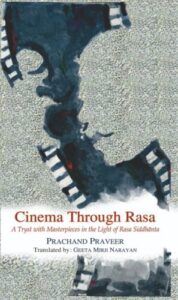A chemical engineer who works with a risk management firm, Prachand Praveer took to writing in his childhood days to express himself, beginning with small stories at first. In 2010, his first Hindi novel, Alpahari Grihatyagi: IIT Se Pahle was published by Harper Hindi. His second book, Abhinav Cinema, published by Dakhal Prakashan in 2016, has recently been translated by Geeta Mirji Narayan. A one-of-its-kind book, Cinema Through Rasa: A Tryst With Masterpieces In The Light Of Rasa Siddhanta (DK Printworld; Rs 640; 376 pages) discusses the important works of world cinema in the light of Rasa Siddhanta of the Indian classical aesthetics. In an interview with Saurabh Tankha, the author talks about writing a book connecting cinema with rasas…
Why cinema?
When I started college, I realised that although I was equipped with the system oriented curriculum, I did not have rounded or holistic education. There were people who knew much more than just history, geography, mathematics or physics. I did have an affinity to films but that was limited to Hindi movies. Cinema is not taught in school; it has to be learnt by oneself. I owe this love for cinema or let me say world cinema to some of my friends and teachers at IIT. My journey to learn started with watching Ladri di Biciclette (Bicycle Thieves), a masterpiece by Vittorio di Sica and the rest as they say is history.
When did the idea of writing a book connecting cinema with rasas strike you i.e the original – Abhinav Cinema? How did you go about collecting facts for it?
I started writing at the behest of some literary friends who said that since I know so much about cinema and that the Hindi literary world doesn’t have any book to guide people, so why don’t I write one, explaining about the concept of saundarya and classical aesthetics. This is how the book came about. I used to have detailed discussions with friends and teachers after watching movies in college. All this led to a deeper study of the philosophy behind Rasa Siddhanta.

The book also draws attention to a number of landmark movies created in the West. Do you think your ‘effort to bring to the reader the films that are good and bring about a sense of well-being in them’ has been successful?
The book draws attention to world cinema not just Western, ie films from Japan, China, Iran and more. It is difficult to ascertain exactly the effect on readers because such things are known only in posterity. But I have feedback from scholars and readers that the book is an eye-opener and is innovative in the sense that it provides the readers with names of so many films and information about them. I hope the English translation reaches a far wider readership and then maybe we can understand the feel-good effect.
Given that you have done deep study and research on cinema, why do you think that ‘filmmakers – Shyam Benegal, Mani Kaul and Kumar Shahani – made excellent art films but these failed to touch a chord with the audiences’?
Art appreciation and reception are bound by two things: public perception and critical appreciation. There is no doubt that Shyam Bengal, Mani Kaul and Kumar Shahani made excellent films, but either one of the above two important aspects were missing which would have propelled them into the world arena. There are many other directors in world cinema who have not really got their due. It is purely lack of public perception and critical appreciation.
What’s up next for Prachand Praveer?
I have a few projects in the pipeline. One is another very short story collection, written over the last 13-14 years, to be published in three parts.